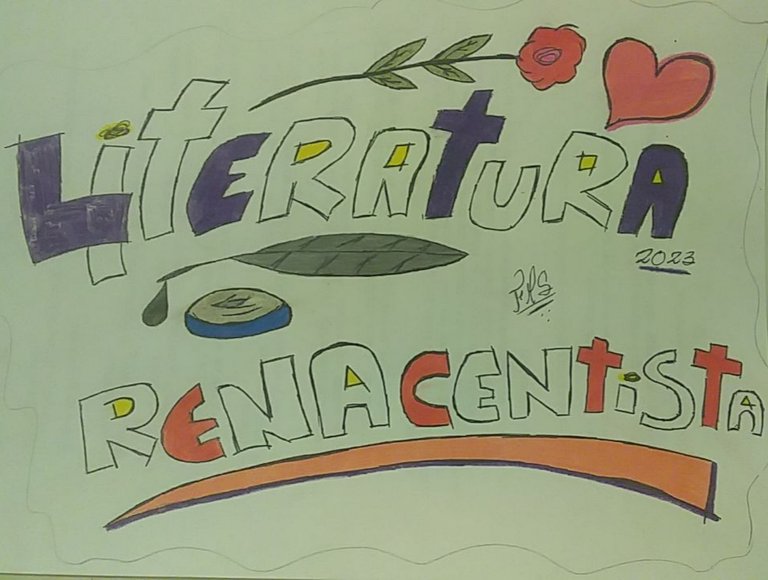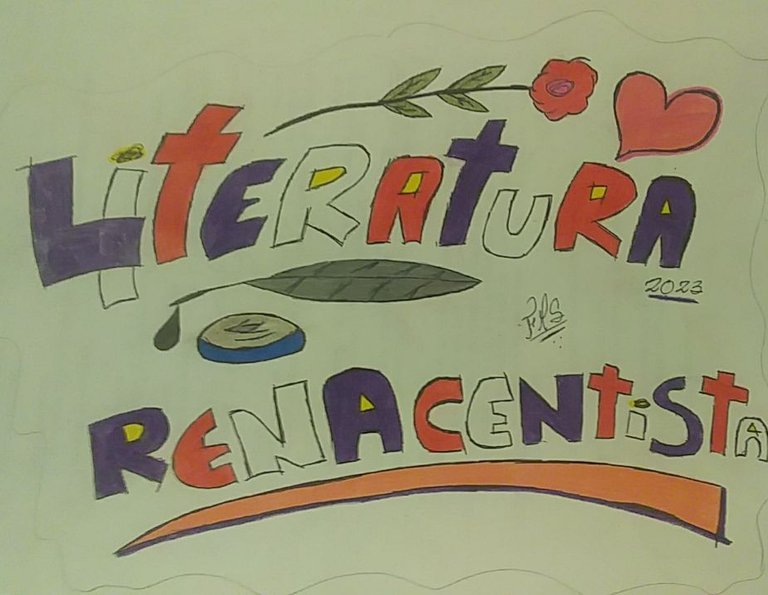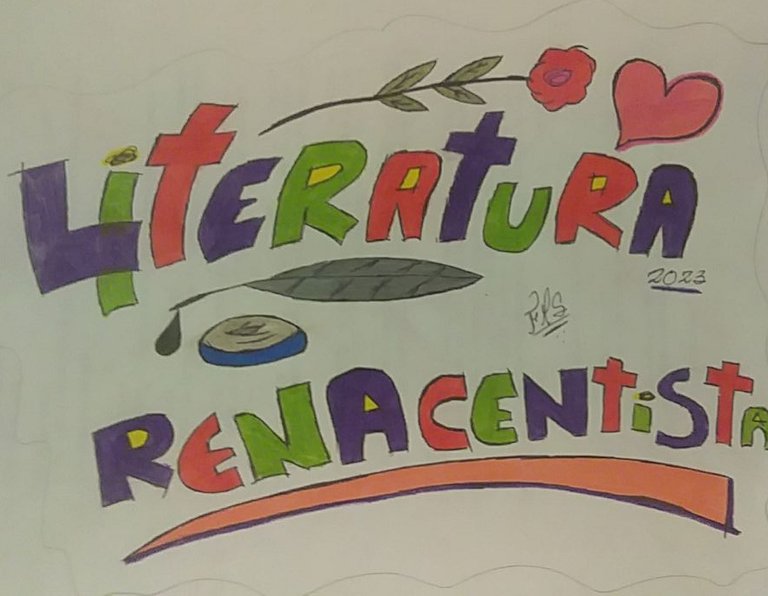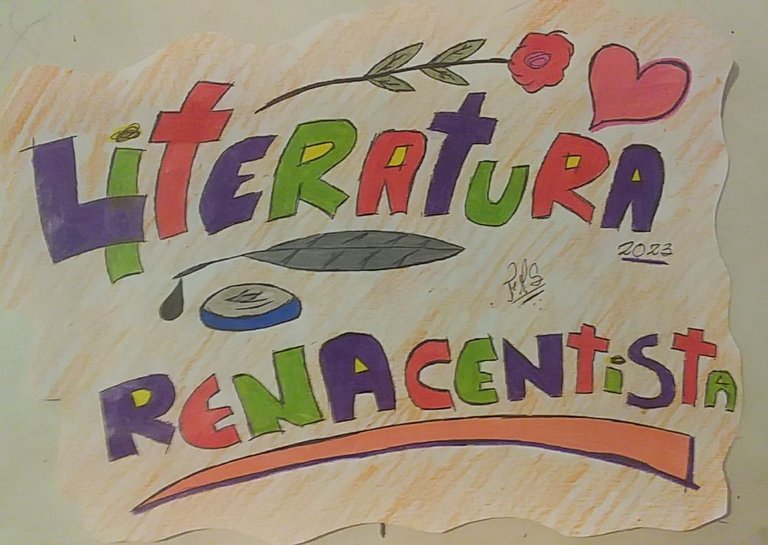
Dibujo realizado por el autor.
Nombre: Literatura renacentista: un cambio de visión, el retorno al ser humano y la oda a lo universal. Por Florencia Renata.

Dibujo realizado por el autor.
El Renacimiento se trató de un período histórico caracterizado por la renovación e innovación de los aspectos relacionados con las artes, la literatura y la ciencia que tuvieron lugar a mediados del siglo XV y se extendieron hasta finales del siglo XVI, aunque hay autores que ubican sus inicios en los finales del siglo XIV. Comenzó en Italia, expendiéndose por toda Europa adoptando características de cada nación. Su principal eje fue el ser humano y todo lo que se relacionara con éste, rompiendo con todos los estatus que rigieron las sociedades hasta ese momento.

Dibujo realizado por el autor.
La literatura fue uno de los centros de difusión de ideas más destacados de este período, ya que impuso como ideal estético la claridad y la naturalidad. El hecho decisivo que ayudó a esta rama del conocimiento fue la aparición e implementación de la imprenta. Sin bien los límites históricos determinan que el renacimiento tuvo lugar desde el siglo XV, existen manifestaciones literarias que coinciden con el estilo propio de esta época que datan del siglo XIII y XIV, observadas principalmente en Italia.

Dibujo realizado por el autor.
La literatura renacentista buscaba plasmarse de realismo crítico enfatizando temas como: el amor, la naturaleza y la mitología, siendo el primero el eje de la poesía lírica, sacando a Dios como centro y reconociendo, así como admirando a la mujer. En esta época, la naturaleza fue idealizada por su gran belleza y por los sentimientos que generaban por su gran magnitud y perfección; mientras que la mitología, fue un tema reiterativo por medio de los personajes más destacados de la antigua Grecia; esto significó el regreso al estilo clásico de aprendizaje ignorado por la mayoría durante la Edad Media.

Dibujo realizado por el autor.
Los escritores y poetas del Renacimiento, lograron difundir sus ideas, del mismo modo que incorporaron idiomas y valores que iban conociendo a medida que viajaban por Europa. La razón fue valorada por encima de la fe y la filosofía greco-romana tomó mayor protagonismo llevando como centro al ser humano.

Dibujo realizado por el autor.
Entre los principales representantes de la literatura renacentista se encontraron: Dante Alighieri (La Divina Comedia), Jean Moliére (Tartufo), Nicolás Maquiavelo (El Príncipe), Baltasar Castiglione (El Cortesano), Miguel De Cervantes (Don Quijote de la Mancha), Edmund Spenser (La Reina de las Hadas), William Shakespeare (Romeo y Julieta), Tomás Moro (Utopía), Luís de Camões (Las Lusíadas), Garcilaso de la Vega y Pierre de Ronsard (Los amores de Casandra).

Drawing by the author.
English: Renaissance literature: a change of vision, the return to the human being and the ode to the universal. By Florencia Renata.

Drawing by the author.
The Renaissance was a historical period characterized by the renewal and innovation of aspects related to the arts, literature and science that took place in the middle of the fifteenth century and extended until the end of the sixteenth century, although there are authors who locate their beginnings in the late fourteenth century. It started in Italy, selling throughout Europe adopting characteristics of each nation. Its main axis was the human being and everything related to it, breaking with all the statuses that governed societies up to that time.

Drawing by the author.
Literature was one of the most outstanding centers of dissemination of ideas of this period, since it imposed clarity and naturalness as an aesthetic ideal. The decisive fact that helped this branch of knowledge was the emergence and implementation of the printing press. Although historical limits determine that the Renaissance took place since the fifteenth century, there are literary manifestations that coincide with the style of this era dating from the thirteenth and fourteenth centuries, observed mainly in Italy.

Drawing by the author.
Renaissance literature sought to translate itself into critical realism emphasizing themes such as love, nature and mythology, the first being the axis of lyric poetry, taking God as the center and recognizing, as well as admiring, women. At this time, nature was idealized for its great beauty and for the feelings they generated for its great magnitude and perfection; while mythology, was a reiterative theme through the most prominent characters of ancient Greece; this meant the return to the classical style of learning ignored by most during the Middle Ages.

Drawing by the author.
The writers and poets of the Renaissance managed to spread their ideas, in the same way that they incorporated languages and values that they came to know as they traveled through Europe. Reason was valued above faith and Greco-Roman philosophy took on greater prominence, taking the human being as its center.

Drawing by the author.
Among the main representatives of Renaissance literature were: Dante Alighieri (The Divine Comedy), Jean Moliere (Tartufo), Nicolás Machiavelli (The Prince), Baltasar Castiglione (The Courtier), Miguel De Cervantes (Don Quixote of la Mancha), Edmund Spenser (The Fairy Queen), William Shakespeare (Romeo and Juliet), Thomas More (Utopia), Luís de Camões (The Lusiads), Garcilaso de la Vega and Pierre de Ronsard (The Loves of Cassandra).